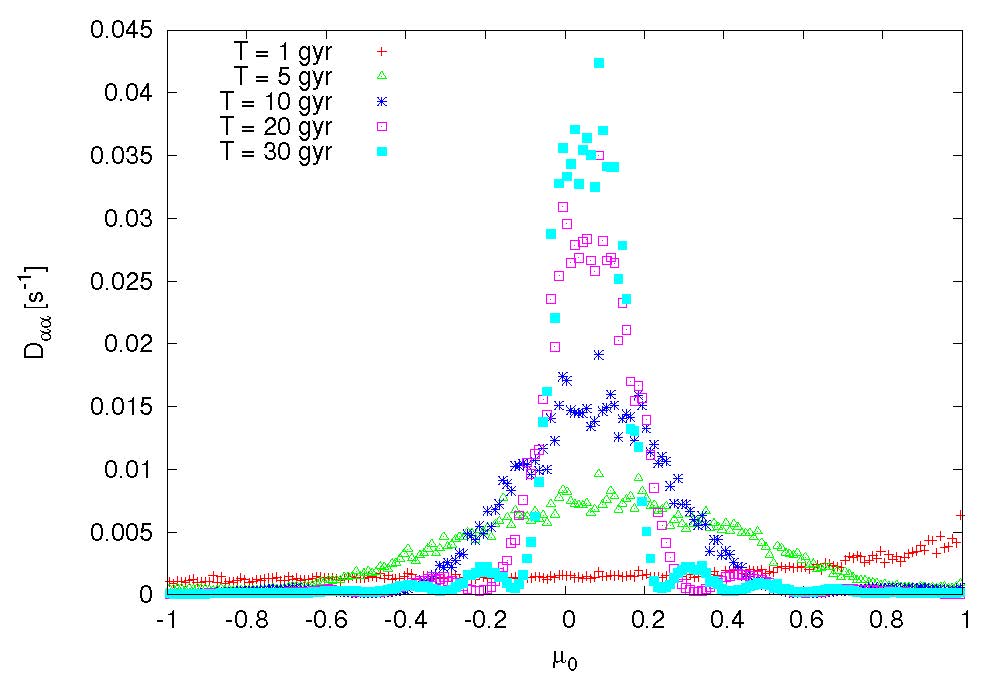Research - Transport
Cosmic radiation consists of charged particles emitted from various sources in the universe - from the sun to distant active galactic nuclei. from the Sun to distant active galactic nuclei. In the process, the particles, mostly electrons or protons, have energies ranging from several keV in the solar range to 1020 eV for extragalactic radiation. Due to the high energy and low density of the background, these particles do not interact by collisions but only by collisions, but only by interacting with magnetic perturbations. These disturbances are usually caused by a turbulence theory. The interaction of the particles themselves is described by transport theory.
An analytical description of the transport theory is extremely complicated due to the non-linear interaction and
is only successful in certain limiting cases. A very comprehensive account can be found in the book. "Cosmic Ray
Astrophysics" by Reinhard Schlickeiser.
I have used analytical theories, for example, to describe the distribution of cosmic rays in elliptical
galaxies. ( Analytical view of diffusive and
convective cosmic ray transport in elliptical galaxies (Hein and Spanier 2008 Astronomy and Astrophysics
)). The complexity of the interaction of plasma waves with cosmic rays is nicely illustrated by the
paper Analytical treatment of particle motion in
circularly polarised slab-mode wave fields (Schreiner, Vainio, and Spanier 2018 Journal of Plasma Physics
): The proof alone that the interaction of a single wave with a single particle is integrable fills
several pages.
A numerical approach to describe particle transport is the test particle approach: The turbulent background of the interplanetary or interstellar medium is simulated and test particles are placed in the resulting magnetic fields and their motion is tracked. In early work, I used compressible MHD simulations for this purpose (Simulation of Charged Particle Diffusion in MHD plasmas (Spanier and Wisniewski 2011 Astrophysics and Space Sciences Transactions ), Diffusion of Energetic Particles in Turbulent Magnetohydrodynamic Plasmas (Wisniewski, Spanier, and Kissmann 2012 The Astrophysical Journal )). However, due to the high numerical dissipation, it is not possible here to obtain a wide wavenumber range of the inertial range of the turbulence. inertial range of the turbulence.
| Therefore, the GISMO code was used later. There the physics of Alfven waves, which is a realistic representation in large parts of the interstellar medium. in large parts of the interstellar medium. One important aspect of the research here is the question of how the transport of particles is changed by the of particles' self-generated turbulence ( evolution of plasma turbulence excited with particle beams (Lange and Spanier 2012 Astronomy and Astrophysics ), Particle scattering in turbulent plasmas with amplified wave modes (Lange, Spanier \emph{et al.} 2013 Astronomy and Astrophysics )). See Turbulence for a discussion of this. For particle transport, in particular, it has been shown that transport by pseudo-Alfven waves significantly alters the diffusion of particles moving perpendicular to the magnetic field. |
 Diffusion coefficient for scattering from self-generated turbulence. The strong scattering for vertically moving particles is striking. Source:Particle scattering in turbulent plasmas with amplified wave modes (Lange, Spanier \emph{et al.} 2013 Astronomy and Astrophysics ) |
Newer research includes transport at dispersive modes (here Whistler modes). This can no longer be MHD model, so a particle-in-cell code is used (Particle Scattering off of Right-Handed Dispersive Waves (Schreiner, Kilian, and Spanier 2017 The Astrophysical Journal )). This is an important preliminary work to simulate particle transport in kinetic turbulence (Wave-particle-interaction in kinetic plasmas (Schreiner and Spanier 2014 Computer Physics Communications )).
A central problem in the analysis of test-particle models is that scattering coefficients are actually well-defined only for quasilinear theory. In test particle simulations, however, the direction and momentum of particles changes. This means that the validity of simulations diminishes with increasing runtime. At the same time, long runtimes are needed to obtain convergent results. We have developed a new approach to the analysis of test particle simulations that is no longer based on the consideration of individual particles but on the temporal evolution of distribution functions. (Determining Pitch-angle Diffusion Coefficients from Test Particle Simulations (Ivascenko, Lange, Spanier, and Vainio 2016 The Astrophysical Journal ))

 Home page
Home page